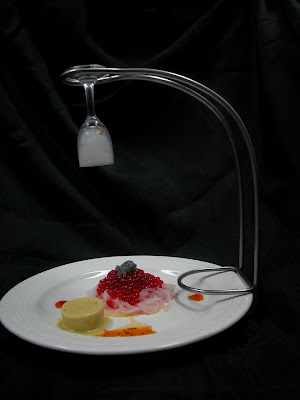I've never met a chef whose hair wasn't clean and off her face. I've never seen a chef with dirty nails or schmutz on his clothes (except food). Enough said.
Professional cooks learn day one that their jobs depend on a certain amount of respect. Respect goes beyond people. It extends to the kitchen, the equipment and the ingredients. Cooks learn early on to clean and store equipment properly and keep their heads down and their stations clean. Our chef at Haven's Kitchen, David, carries on the Thomas Keller torch with the constant reminder that "ingredients don't come from the walk in. They come from the farmer." It's not just a piece of meat or a potato; it's someone's hard work. Or in the case of the meat, a cow's life.
Owing in part to that respect, professional cooks learned ages ago how to use the entire vegetable, or pig, or what have you. They've known forever how to manage waste by thoughtfully planning, storing and utilizing. On top of the fundamental understanding of what went into those ingredients, chefs know more than anyone how expensive those ingredients get. And restaurants need as close to zero waste to be close to economically viable.
Chefs know better than anyone that we learn by doing. But when there are paying customers out in the dining room, there can't be any mistakes. So the kitchen is a veritable hotbed of education. Line cooks build on the technical skills they've learned in a real time environment. It's what separates the cooks from the chefs. And while the chefs who work at Haven's are actually teaching classes, all chefs learn from other chefs, and all chefs teach other chefs. Chef David phrased it this way "We're all constantly learning and constantly teaching." It's a beautiful system and one that has remained mostly untouched.
Building on #4, no young cook eager for a career in the food world would dream of opening a restaurant before working her way up the ranks at other restaurants. In the chef world you start at A and maybe, with a ton of hard work, burns, cuts and blisters, maybe get to C. Or G. Or whatever. But if you've ever heard a 20-something question why he shouldn't just be hired as a CEO, you may agree that the idea of working one's way through the ranks seems like an anachronism to many of our young people. I see that as a problem and it's virtually non-existent in the restaurant community.
This goes back to neatness and respect, but watching the pros work is like watching a beautiful ballet. It's passionate and full of talent, but the technical piece is critical to a truly special end result. Chefs learn to make their mis en place, which literally means, "putting in place" before they turn on a burner. Everything is cleaned, measured, chopped, and then laid out on the prep station, making the process smoother and easier, not to mention less vulnerable to mistakes. For the most part, chefs are trained to clean their workspaces and tidy up after each step of the preparation. I've adopted both techniques in my home cooking and it's made a world of difference (plus I feel cool).
If you've ever been in a professional kitchen, it's most definitely not smooth sailing all the time. Things get messed up. It just happens. And there's no ordering take out if the main course burns. So chefs learn to improvise, use what they have and make it work. I wish we could all do that... instead of hitting a brick wall and breaking down crying, chefs say, "Huh. A brick wall. Let's see how I can get over, under, around or through it." Admirable.
While we see a lot of big egos on television food shows, the world of restaurant chefs is all about mutual respect, admiration and working together to make beautiful food. For every component on the plate at your next restaurant meal, there was probably at least one cook responsible for the dicing, slicing, par boiling, shocking, pickling... you get it. It takes a village to make a restaurant meal.
I've covered the appreciation and respect of ingredients, and this is a bit of an extension of all that. Jonathan Benno, who trained David at Per Se and was trained by Thomas Keller, has a famous quote in the chef world that is something along the lines of, "show me how to use NaCl and then I'll show you the rest." Molecular is great, foams are fabulous, but good cooking is already all about chemistry and alchemy. The fundamental understanding of natural laws and reactions is a part of a chef's daily work. Wouldn't it be amazing if that was how they taught high school science?
The most wonderful part of working with professional cooks and chefs is the absolute love they have for feeding and nurturing people. Some are quieter than others. Most I know are somewhat introverted. But watching them work and transform their ingredients to create the food we eat is a privilege I enjoy every day. Even if its as simple as olive oil, salt and some acid, chefs touch their food with a certain magic, and as I watch, I'm stuck by how lucky these people are to have figured out what gives them pleasure. And then they figured out how to make a living doing it. That's a skill more of us need. I know perfectly well that not all cooks are in the kitchen out of love, but I bet if you asked the vast majority of them if it's just a job, they would say no. It's too challenging, too hot, too intense to be just a job. It's a labor of love.































